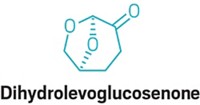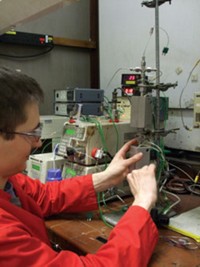Advertisement
Grab your lab coat. Let's get started
Welcome!
Welcome!
Create an account below to get 6 C&EN articles per month, receive newsletters and more - all free.
It seems this is your first time logging in online. Please enter the following information to continue.
As an ACS member you automatically get access to this site. All we need is few more details to create your reading experience.
Not you? Sign in with a different account.
Not you? Sign in with a different account.
ERROR 1
ERROR 1
ERROR 2
ERROR 2
ERROR 2
ERROR 2
ERROR 2
Password and Confirm password must match.
If you have an ACS member number, please enter it here so we can link this account to your membership. (optional)
ERROR 2
ACS values your privacy. By submitting your information, you are gaining access to C&EN and subscribing to our weekly newsletter. We use the information you provide to make your reading experience better, and we will never sell your data to third party members.
Biobased Chemicals
New solvent, Cyrene, takes on NMP
With help from the lab services giant Merck KGaA, Circa sends its biobased solvent into the world
by Michael McCoy
May 30, 2019
| A version of this story appeared in
Volume 97, Issue 22


A small Australian company called Circa Group and the lab services giant Merck KGaA have teamed up to launch a new solvent intended to replace two old but environmentally suspect standbys: N-methyl-2-pyrrolidone (NMP) and dimethyl formamide (DMF).
The launch closely follows Circa’s opening of a prototype plant in Tasmania, Australia, that can produce up to 20 metric tons (t) per year of the solvent, a cellulose-derived molecule named Cyrene. Its chemical name is dihydrolevoglucosenone.

NMP and DMF are big businesses. Merck estimates global production capacities at 125,000 t per year for NMP and 225,000 t for DMF. But the solvents are under environmental scrutiny. The European Union classifies both as substances of very high concern. And, starting May 2020, consumer products containing more than 0.3% NMP will be restricted in the EU.
In the US, NMP is a priority substance under the Toxic Substances Control Act, and several retailers are phasing it out of paint strippers. Users in the chemical industry are also moving away from the solvents. DSM, for example, recently vowed to phase out NMP from its resin-products portfolio by July 2020.
NMP and DMF are members of a family of nitrogen-containing dipolar aprotic solvents that also includes dimethylacetamide. Although these solvents have been under scrutiny for some time, companies continue to use them because they offer high chemical and thermal stability and provide good solvency for a wide range of organic and inorganic compounds. Applications include research as well as industrial uses like drug manufacturing and polymer processing.
Cyrene can’t replace them in every application, but Fabien Deswarte, Circa’s business development manager, says interest is high and initial results promising. Directly and through Merck and a Dutch distributor, Will & Co., Circa has sent samples to hundreds of companies and academic institutions, he says.
Among the firm’s target markets is the production of polyamide-imide, a wire-coating polymer that is one of the largest European outlets for NMP, Deswarte says. Other targets include solvents used to clean electronics and manufacture polyether sulfone and polyvinylidene fluoride membranes.
Cyrene’s origins go back more than a decade, when the paper industry was confronting declining demand and looking for new revenue sources. In Australia, a team led by the paper-industry executive Tony Duncan identified levoglucosenone as a molecule that could be easily derived from cellulose waste.
After hearing James Clark, a University of York professor and director of the Green Chemistry Centre of Excellence, on the radio, Duncan approached him for help in finding uses for levoglucosenone. “It was a process and product looking for a home,” Clark recalls. His idea was to hydrogenate it and try it as a solvent.
“It turned out to be very, very good,” Clark says. “It’s surprising that a carbohydrate can do this. I can’t claim to fully understand why.”
Since then, Clark has tried Cyrene in a number of applications. Working with research partners in Spain, for example, his group successfully replaced NMP in the exfoliation of graphite to produce graphene. “It works really well—better than NMP,” he says.
Merck got involved about 4 years ago after learning about Cyrene and seeing its potential, says Jane Murray, the firm’s global head of green chemistry. Among other efforts, Merck sponsored Kirsty L. Wilson, a PhD student in Allan Watson’s group at the University of St. Andrews, who studied replacing DMF with Cyrene in medicinal chemistry.
Murray and Deswarte see Merck’s life sciences lab chemicals business as a way to get Cyrene into the hands of industrial researchers who will take the solvent to the marketplace.
For example, Alessandro Napoli, global technology manager for industrial components at Huntsman Advanced Materials, is exploring Cyrene as a replacement for NMP and other solvents. In one project, Napoli’s team used it in place of N-ethyl-2-pyrrolidone in the polymerization and dispersion of a specialty polyimide. Although Cyrene was not a drop-in replacement, the results were promising, he says.
It’s a long way from good lab results to the commercial marketplace, Napoli acknowledges. Performance in real-world applications needs to be tested. And Huntsman needs assured supplies at an acceptable price. But Napoli is excited to be on the leading edge of solvent replacement. “For us it’s been a great opportunity to explore something new and emerging,” he says.





Join the conversation
Contact the reporter
Submit a Letter to the Editor for publication
Engage with us on Twitter